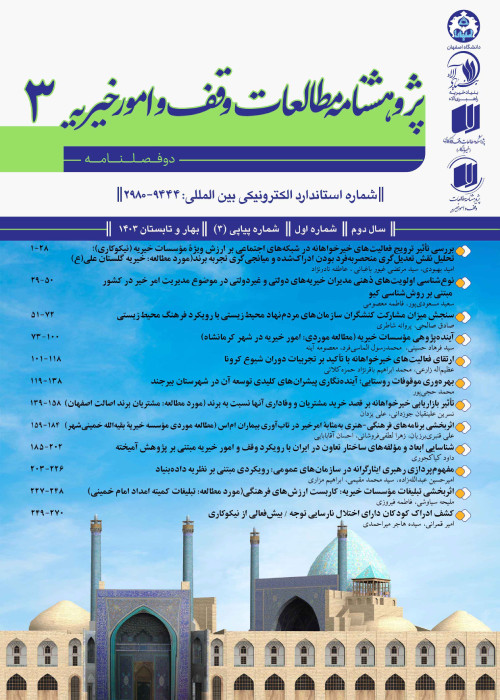Discovery of the Perception of Children with Attention-Deficit/Hyperactivity Disorder from the Charity
Benevolence as a human deed is influenced by the desires, mindsets, experiences, and psychological states of people. Various psychological states can affect benevolence like all human behaviors and perceptions. Benevolence is not limited to giving to individuals, but also includes giving to all living things, and is considered a moral and human responsibility beyond a Sharia duty (Ayyari and Mousapour, 2023). Since the benefits of benevolence are evident in society, the importance of developing a benevolent society through the development of benevolence in children and paying attention to the early stages of the transformation of benevolence in people including childhood is obvious. Good deeds are also very effective in the psychological development of children, and children benefit from good deeds like adults. Research shows that benevolence in each provider (child and adult) is associated with increased attributes of gratitude. Benevolence towards peers significantly increases the self-esteem of the child (Hu, et al., 2023). The experience of the researchers of the present study in teaching and clinical work with children, as well as the importance and value of philanthropy in the psychological transformation of individuals and the moral development of society, led to questions about the impact of a psychological condition such as Attention Deficit/Hyperactivity on children's perception of the concept of philanthropy; Therefore, this research seeks to understand how symptoms of Attention-Deficit/Hyperactivity Disorder affect children's perception of philanthropy.
The present research project is a qualitative analysis of the inductive content. The research participants were 10 children aged 6 to 12 with Attention Deficit/Hyperactivity Disorder in Isfahan. Sampling was done in a non-random manner (targeted sampling) based on information saturation. The technique of this study was a semi-structured interview type. For the preparation of Interview Questions, a review of the research literature and a consultation with the professors was carried out. The data was collected, recorded, and coded in three months and classified into main and sub-themes. The data analysis method was a thematic analysis based on Brown and Clark's 6-step model including 1) familiarity with data, 2) encoding, 3) searching for subjects, 4) reviewing subjects, 5) defining and naming subjects, and 6) writing an analysis report. Four indicators of Guba and Lincoln credit, namely validation, verifiability, reliability, and transferability, were used to ensure validity and reliability. To increase the validity of the findings, long-term involvement with interviewees (4 months) was considered.
The findings are in the form of 5 main themes (the concept of benevolence, the characteristics of benevolent people, the person's perception of his own benevolence, the person's perception of the benevolence of others and the identity of stakeholders) and 17 sub-themes (objective-general conceptualization of benevolence, the incompetence of benevolence from similar concepts, the obligatory perception of the nature of benevolence, the paradoxical conceptualization of benevolence, the lack of perception of the concept of hypocrisy in benevolence, the lack of attention to the elements that encourage benevolence in the media, understanding benevolence as a construct of positive human traits, self-centeredness in judging the characteristics of benevolent people, contradiction in the formulation of the characteristics of benevolent people, impulsive measurement of your benevolence, limited processing of your emotions and stakeholder during doing good deed, interpreting the good deeds of others in my halo, not understanding good deeds as a purely human act, the combination of the beloved and the benefactor, the projection of their own inner-psychological reality in the choice of stakeholder identity, the paradox in the definition of the benefactor, the objective and general definition of the benefactor) that represent the participants ' perceptions of the benefactor.
The present study was designed to explore the perceptions of children with Attention Deficit/Hyperactivity from charity. Understanding the perceptions of these children is important as in Iran, the topic of charity has recently been scientifically examined and is doubled in importance by considering the very small number of research on charity in children. The results of this study, as any other qualitative study that has an exploratory nature, obtained innovative findings. The theoretical importance of the research findings is debatable from the perspective of psychological theories and philanthropy.
Other theories that can be cited in the explanation of the research findings are special theories of benevolence, such as the model of expanded interest and consequential social preferences (Moghadam and Esmaili, 2023). Citing the assumptions of these theories, it is expected that the perception of children with Attention Deficit/Hyperactivity towards the paradoxical conceptualization of benevolence and the obligatory perception of the nature of benevolence (not seeing other intentions in a benevolent process) and judging the characteristics of benevolent people and the identity of stakeholders will be formed based on the personal and inner preferences of the child.
Overall, the results of this study helped to further understand the mental world of children with Attention Deficit/ Hyperactivity from the category of charity. However, conducting and repeating studies that examine this conceptualization and perceptions in children with other cognitive and sensory impairments, IQ impairment, as well as uninjured children can allow for a comprehensive comparison and understanding of children's perceptions of the category of charity.
- حق عضویت دریافتی صرف حمایت از نشریات عضو و نگهداری، تکمیل و توسعه مگیران میشود.
- پرداخت حق اشتراک و دانلود مقالات اجازه بازنشر آن در سایر رسانههای چاپی و دیجیتال را به کاربر نمیدهد.


